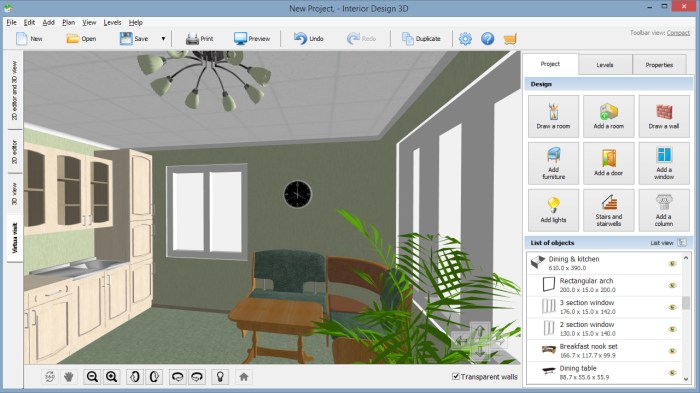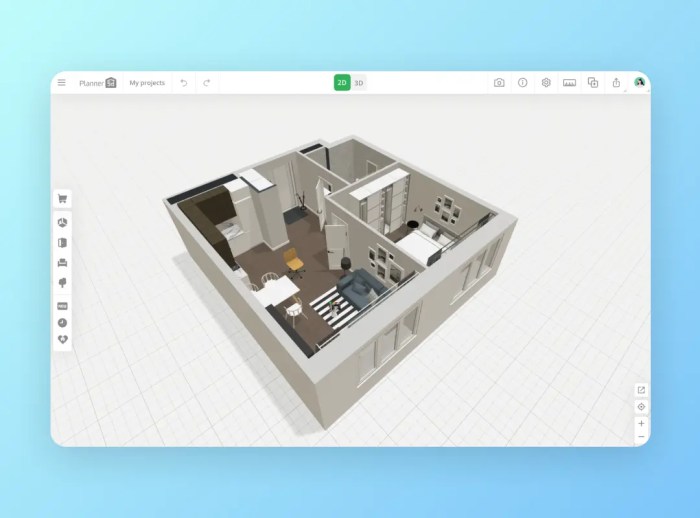Best interior design software for beginners: A Comprehensive Guide

Embarking on the journey of interior design software for beginners opens up a realm of creativity and innovation. This guide dives deep into the world of design tools, features, and customization options, ensuring a smooth transition into the realm of interior design.
Exploring the intricate details of user-friendly interfaces, essential tools, design capabilities, and budget-friendly options, this guide equips beginners with the necessary knowledge to kickstart their design projects.
Overview of Interior Design Software
Interior design software is essential for beginners to create professional and visually appealing designs for residential or commercial spaces. It helps users visualize their ideas, experiment with different layouts, colors, and furniture, and make informed decisions before implementing the designs.
When choosing interior design software as a beginner, it is important to look for key features that can enhance the design process. These features include user-friendly interfaces, drag-and-drop functionality, a wide range of furniture and decor options, 3D modeling capabilities, and the ability to generate detailed floor plans and layouts.
Types of Interior Design Software for Beginners
- 1. RoomSketcher: RoomSketcher is a popular choice for beginners due to its intuitive interface, drag-and-drop functionality, and extensive library of furniture and decor items.
- 2. SketchUp: SketchUp is another beginner-friendly software that offers powerful 3D modeling tools and a user-friendly interface, making it easy to create detailed interior designs.
- 3. HomeByMe: HomeByMe is a web-based interior design software that allows beginners to create realistic 3D models, experiment with different design ideas, and visualize the final look of their space.
- 4. Planner 5D: Planner 5D is a user-friendly interior design software that offers both 2D and 3D design capabilities, making it easy for beginners to create detailed floor plans and visualize their designs in 3D.
User-Friendly Interface

Having a user-friendly interface in interior design software is crucial for beginners as it makes the process more accessible and less intimidating. A well-designed interface can help users navigate the software efficiently, easily access tools and features, and create designs with confidence.
Examples of Interior Design Software with Intuitive Interfaces
- SketchUp: Known for its simple and intuitive interface, SketchUp is popular among beginners for its ease of use and flexibility in creating 3D designs.
- HomeByMe: This software offers a drag-and-drop interface that allows users to easily visualize their design ideas without the need for extensive training.
- Sweet Home 3D: With a straightforward interface and a library of furniture and textures, Sweet Home 3D is ideal for beginners looking to create basic interior designs.
Tips on Navigating Through the Software for Beginners
- Start with tutorials: Many interior design software offer tutorials and guides to help beginners get acquainted with the interface and features. Take advantage of these resources to build your skills.
- Practice with simple projects: Begin by working on small, straightforward projects to familiarize yourself with the software's tools and functions before moving on to more complex designs.
- Customize your workspace: Adjust the software settings to suit your preferences and workflow, making it easier for you to access frequently used tools and features.
- Experiment and explore: Don't be afraid to experiment with different tools and features within the software. The more you explore, the more comfortable you will become with the interface.
Tools and Features
Interior design software for beginners should offer essential tools and features to assist in creating stunning designs without overwhelming the user. These tools play a crucial role in simplifying the design process and helping beginners bring their ideas to life.
Comparison of Tools in Different Software
When comparing different interior design software options for beginners, it is important to look for key tools such as:
- Drag-and-Drop Functionality: Allows users to easily place furniture, fixtures, and decor items in their designs without complex commands.
- Library of Objects: A wide selection of pre-made objects like furniture, textures, and materials to choose from, saving time and effort in creating designs from scratch.
- Room Templates: Pre-built room templates for common spaces like living rooms, kitchens, and bedrooms to provide a starting point for beginners.
- 3D Visualization: Tools that enable users to view their designs in 3D, helping them understand spatial relationships and visualize the final look of the space.
- Color Palette Selection: Options for choosing color schemes and experimenting with different combinations to achieve the desired aesthetic.
Importance of Tools and Features
These tools and features are essential for beginners as they simplify the design process and make it more accessible. Drag-and-drop functionality eliminates the need for complex design skills, while a library of objects provides inspiration and resources for creating detailed designs.
Room templates offer a starting point for those new to interior design, helping them understand layout and design principles. 3D visualization allows users to see their designs come to life, making it easier to make adjustments and improvements. Finally, color palette selection tools help beginners experiment with different color schemes and find the perfect combination for their designs.
Design Capabilities

Interior design software for beginners offers a range of design capabilities to help users bring their creative ideas to life. These capabilities vary from software to software, but generally include tools for creating floor plans, 3D models, and realistic renderings of interior spaces.
Let's explore some of the design projects that can be accomplished using this software and discuss the limitations beginners may face in terms of design complexity
Sample Design Projects
- Create detailed floor plans with accurate measurements and layout of furniture.
- Design custom furniture pieces and experiment with different colors, textures, and materials.
- Visualize room layouts with 3D models to understand the spatial arrangement better.
- Add lighting fixtures, decor items, and other accessories to enhance the overall look of the space.
- Produce realistic renderings of interior spaces to showcase the design concept to clients or collaborators.
Limitations for Beginners
- Complex design features may be overwhelming for beginners with limited experience in interior design.
- Some software may have a steep learning curve, requiring time and effort to master all the tools and functions.
- Beginners may struggle with advanced techniques like creating custom textures or intricate patterns.
- Limited design templates or pre-built elements may restrict the creative freedom of beginners in their projects.
Customization and Personalization
When it comes to interior design software for beginners, customization and personalization play a crucial role in creating unique and tailored projects. These features allow users to bring their creative vision to life and add a personal touch to their designs.
Importance of Customization Options
Customization options in interior design software enable users to adjust colors, textures, furniture, and other elements to suit their preferences and style. This flexibility empowers beginners to experiment with different combinations and layouts, helping them develop their design skills and create truly personalized spaces.
- Customization options help beginners explore their creativity and develop a unique design style.
- Personalizing projects allows users to reflect their personality and taste in their designs.
- By customizing details such as lighting, fabric patterns, and decor items, beginners can enhance the overall look and feel of their designs.
Tips for Creating Unique Designs
To make the most of customization features in interior design software, beginners can follow these tips to create standout projects:
- Experiment with different color palettes and textures to add depth and visual interest to your designs.
- Customize furniture pieces to fit the dimensions and style of the space, ensuring a cohesive and harmonious look.
- Personalize decor elements such as artwork, rugs, and accessories to infuse personality into the design and create a welcoming atmosphere.
- Utilize advanced customization tools like 3D modeling and rendering to visualize your designs in a realistic setting and make informed decisions.
Budget-Friendly Options
When it comes to interior design software for beginners, finding a budget-friendly option is crucial for those who are just starting out in the field. Fortunately, there are several affordable or even free software options available that still offer valuable features to help you bring your design ideas to life.
Free Software Options
If you are looking for a free interior design software, there are a few options to consider. One popular choice is Sweet Home 3D, which is a free and open-source software that allows you to design floor plans and arrange furniture with ease.
Another option is SketchUp Free, which offers a basic version of their software for free with limited features but still enough to get started with your design projects.
Low-Cost Software Options
For those willing to invest a little bit of money in their interior design software, there are also some affordable options available. Home Designer Suiteis a great choice for beginners, offering a range of features at a reasonable price. RoomSketcheris another budget-friendly option that allows you to create 2D and 3D floor plans, as well as visualize your designs in real-time.
Comparison of Pricing Structures
When comparing the pricing structures of different interior design software, it's important to consider not only the initial cost but also any additional fees or subscriptions required for full access to all features. Some software may offer a one-time purchase option, while others may require a monthly or yearly subscription.In conclusion, there are plenty of budget-friendly options available for beginners in interior design.
Whether you opt for a free software like Sweet Home 3D or invest in a low-cost option like Home Designer Suite, you can find a tool that suits your needs and helps you unleash your creativity in designing beautiful spaces.
Outcome Summary
As we conclude this exploration of interior design software for beginners, it becomes evident that the right tools and features can truly elevate one's design journey. With a plethora of options at hand, beginners are now empowered to unleash their creativity and transform their design visions into reality.
Essential Questionnaire
Is it necessary to use interior design software as a beginner?
Using interior design software as a beginner is highly recommended as it provides essential tools and features to streamline the design process and bring creative ideas to life.
Are there free options available for beginners?
Yes, there are budget-friendly or even free interior design software options that beginners can explore to hone their skills without a significant financial investment.
How can customization options enhance the design process for beginners?
Customization options allow beginners to add a personal touch to their projects, creating unique and visually appealing designs that reflect their individual style and preferences.

